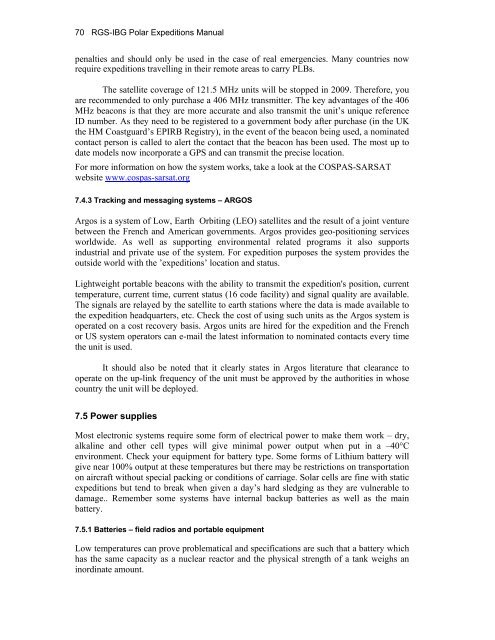Edited by Rachel Duncan 4th Edition ISBN 0-907649-91-2 London ...
Edited by Rachel Duncan 4th Edition ISBN 0-907649-91-2 London ...
Edited by Rachel Duncan 4th Edition ISBN 0-907649-91-2 London ...
You also want an ePaper? Increase the reach of your titles
YUMPU automatically turns print PDFs into web optimized ePapers that Google loves.
70 RGS-IBG Polar Expeditions Manual<br />
penalties and should only be used in the case of real emergencies. Many countries now<br />
require expeditions travelling in their remote areas to carry PLBs.<br />
The satellite coverage of 121.5 MHz units will be stopped in 2009. Therefore, you<br />
are recommended to only purchase a 406 MHz transmitter. The key advantages of the 406<br />
MHz beacons is that they are more accurate and also transmit the unit’s unique reference<br />
ID number. As they need to be registered to a government body after purchase (in the UK<br />
the HM Coastguard’s EPIRB Registry), in the event of the beacon being used, a nominated<br />
contact person is called to alert the contact that the beacon has been used. The most up to<br />
date models now incorporate a GPS and can transmit the precise location.<br />
For more information on how the system works, take a look at the COSPAS-SARSAT<br />
website www.cospas-sarsat.org<br />
7.4.3 Tracking and messaging systems – ARGOS<br />
Argos is a system of Low, Earth Orbiting (LEO) satellites and the result of a joint venture<br />
between the French and American governments. Argos provides geo-positioning services<br />
worldwide. As well as supporting environmental related programs it also supports<br />
industrial and private use of the system. For expedition purposes the system provides the<br />
outside world with the ’expeditions’ location and status.<br />
Lightweight portable beacons with the ability to transmit the expedition's position, current<br />
temperature, current time, current status (16 code facility) and signal quality are available.<br />
The signals are relayed <strong>by</strong> the satellite to earth stations where the data is made available to<br />
the expedition headquarters, etc. Check the cost of using such units as the Argos system is<br />
operated on a cost recovery basis. Argos units are hired for the expedition and the French<br />
or US system operators can e-mail the latest information to nominated contacts every time<br />
the unit is used.<br />
It should also be noted that it clearly states in Argos literature that clearance to<br />
operate on the up-link frequency of the unit must be approved <strong>by</strong> the authorities in whose<br />
country the unit will be deployed.<br />
7.5 Power supplies<br />
Most electronic systems require some form of electrical power to make them work – dry,<br />
alkaline and other cell types will give minimal power output when put in a –40°C<br />
environment. Check your equipment for battery type. Some forms of Lithium battery will<br />
give near 100% output at these temperatures but there may be restrictions on transportation<br />
on aircraft without special packing or conditions of carriage. Solar cells are fine with static<br />
expeditions but tend to break when given a day’s hard sledging as they are vulnerable to<br />
damage.. Remember some systems have internal backup batteries as well as the main<br />
battery.<br />
7.5.1 Batteries – field radios and portable equipment<br />
Low temperatures can prove problematical and specifications are such that a battery which<br />
has the same capacity as a nuclear reactor and the physical strength of a tank weighs an<br />
inordinate amount.

















